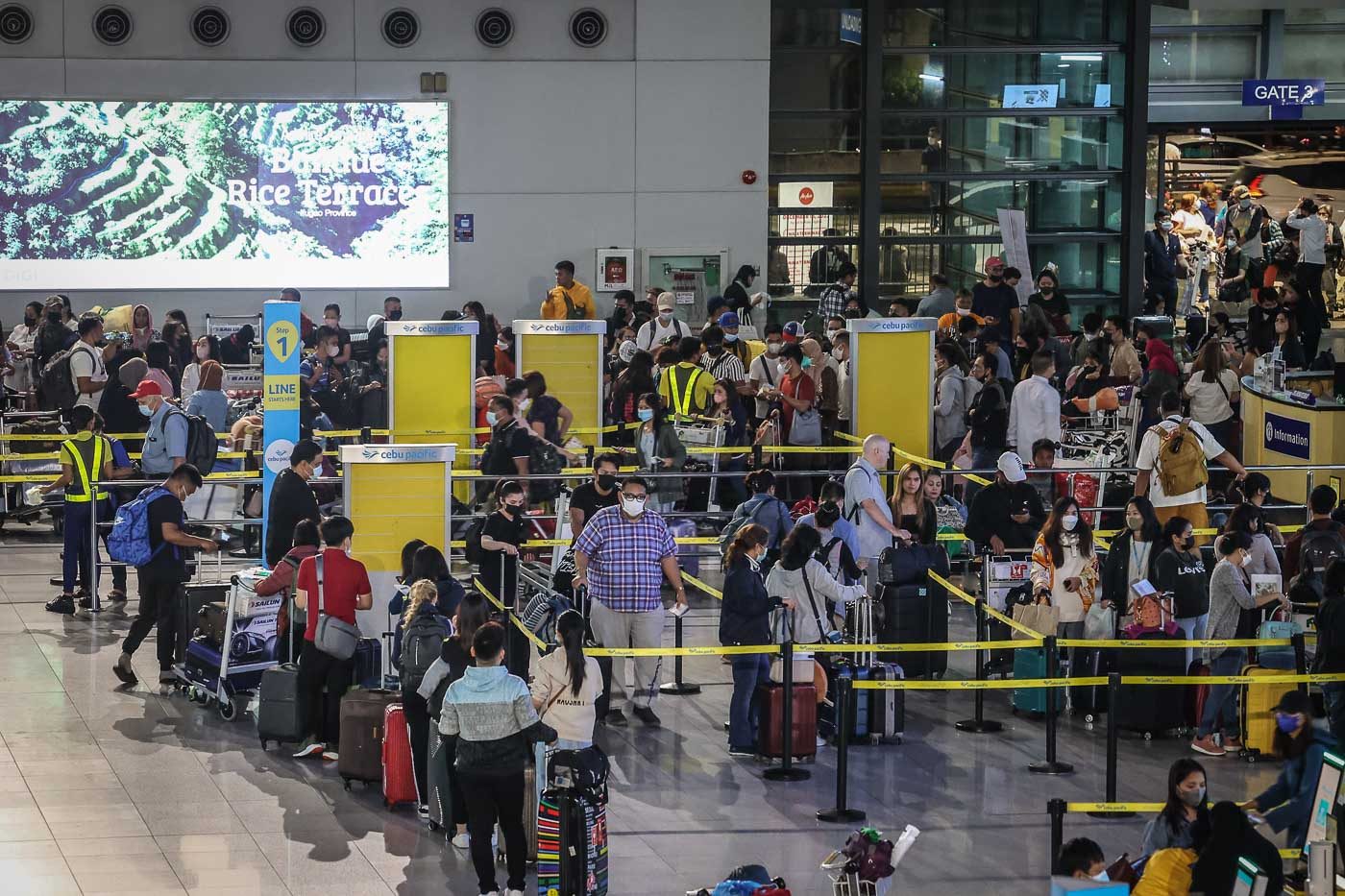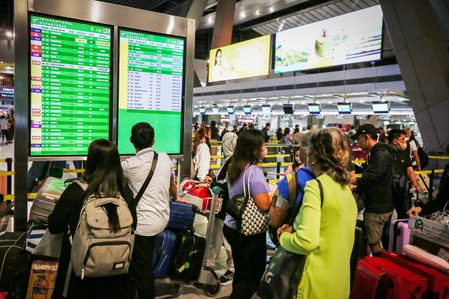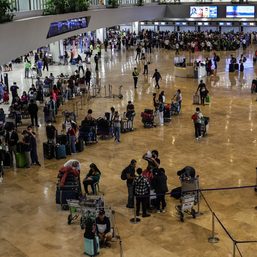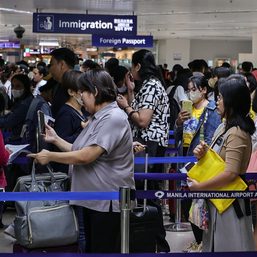SUMMARY
This is AI generated summarization, which may have errors. For context, always refer to the full article.

MANILA, Philippines – Another holiday, another outage – or so it seems, as the Ninoy Aquino International Airport (NAIA) suffered a power outage yet again on Labor Day.
Electricity has already been restored at NAIA Terminal 3, but the damage has already been done. Around 9,000 passengers are grappling with disruptions from delayed or canceled flights, and 24 round-trip domestic Cebu Pacific flights have been canceled altogether.
This latest incident comes just as the government is contemplating a multibillion rehabilitation project to modernize NAIA. (READ: Tycoons reassemble for P100-billion NAIA rehab. What’s new this time?)
Here’s what we know so far.
What happened?
At around 1:05 am, a power outage struck NAIA Terminal 3 after its main circuit breaker tripped. About 15 minutes later, Meralco personnel arrived at the terminal to conduct an initial assessment. Because a component of Meralco – its elbow connector – was also damaged by the outage, repair time was extended.
Although the main circuit breaker managed to shut off power before it could further damage electrical systems, personnel still had to take time to check whether the remaining lines and cables were “clean,” or still capable of delivering electricity.
At around 6 am, Meralco said that its side was “fully energized,” but power to the airport terminal was only fully restored by 8:46 am.
Meralco is still conducting its initial investigation into what exactly caused the outage.
“We are still about to determine the real cause,” said Noel Espiritu, a Meralco engineer, during a press briefing on Monday, May 1. “There was a fault indication at the main circuit breaker at NAIA 3. ‘Yung fault current po na ‘yon ay umakyat din po sa side ng Meralco. Nagkaroon din ng circuit tripping.” (That fault current also affected Meralco’s side. It caused a circuit tripping.)
The “fault current” that triggered the main circuit breaker of NAIA Terminal 3 could come from any part of the electrical system, according to Meralco. There was also no physical manifestation of where the fault came from, such as burned wiring or circuit breakers, further complicating the investigation.
This means that from the early morning hours until commercial power was restored, the airport terminal had to rely on its generator.
“After this power interruption, MIAA immediately turned on its generator sets and partially supplied power,” Transportation Secretary Jaime Bautista said during the briefing.
“Unfortunately, the existing generator of MIAA Terminal 3 cannot support the total power requirement of Terminal 3. I understand it can only support the mission critical areas. Because of that, there are areas in Terminal 3 without air conditioning. There were passengers who were affected by a little bit high temperature.”
MIAA’s generator set can support only 30% of the NAIA Terminal 3’s load. According to Bautista, only these areas could be powered by the generator:
- Check-in systems
- Immigration system
- Final security x-ray
- Aerobridges
- Baggage carousel
- Elevators, escalators, walkalators
- Air conditioning systems for select areas
- Lights
Because power was provided to these areas, passenger check-ins and flight arrivals and departures could still proceed, although with some delays.
Why does this keep happening?
This is not the first time this happened. Power outages had crippled the same terminal in 2016 and most recently, in September 2022.
NAIA Terminal 3 is hampered by its history. The terminal began construction back in the late 1990s. Allegations of anomalies surrounding the terminal have continuously delayed its opening, which was originally scheduled in 2022.
The legal battles between the government and the Philippine International Airport Terminal Co. (Piatco) – the terminal’s main construction contractor – reached the Supreme Court and the International Chamber of Commerce. Eventually, the Philippine government paid out P3 billion to Piatco in 2006, and possession of the terminal was transferred to MIAA.
Terminal 3 opened in 2008, operating at partial capacity. Full operations only commenced in 2014 after the government tapped Takenaka Corporation to rehabilitate the terminal.
However, until now, the government has yet to receive from its contractors some of the terminal’s plans.
“Hindi nai-turn over din lahat ng documents, ‘yung mga manual. Nanghihingi ang Meralco ng as-built plans. Hindi naibigay sa MIAA,” Bautista said during the briefing.
(Not all of the documents and manuals were turned over. Meralco was asking for the as-built plans, but they weren’t turned over to MIAA.)
“Tinitingnan namin ‘yung possibility to get all these documents from Takenaka since nabayaran na ang Piatco. Dapat siguro i-turn over lahat ng mga documents na kailangan ng MIAA,” the transportation secretary added.
(We’ll look at the possibility of getting these documents from Takenaka since we’ve already paid Piatco. The documents should already be turned over to MIAA.)
NAIA Terminal 3 was also originally designed to host only limited concessionaires. But operations in the terminal have gradually increased, with more concessionaires, flights, and air conditioning units, causing its power requirement to balloon.
“The incident shows another disruptive failure of the airport systems, causing grave inconvenience to travelers,” Senator Grace Poe, who chaired several Senate hearings on the New Year’s Day air traffic fiasco, said in a statement. “The lack of functioning air conditioners in several parts of the airport is not only troublesome, but could even be precarious to health, especially of the elderly.”
“Wala tayong nakikita na, no-nonsense effort para siguruhin na hindi na ito maulit,” Senate Majority Leader Joel Villanueva said in a statement “Definitely, hindi puwedeng hindi namin singilin ang mga concerned government authorities dito sa nangyayari na ito.”
(We’re not seeing any no-nonsense effort to ensure that this won’t happen again. Definitely, we cannot allow the authorities responsible for this to just slip past us.)
What happens now?
In light of this, Transportation Secretary Bautista said it’s time to do a full electrical audit of NAIA Terminal 3 – and perhaps even Terminals 1 and 2.
Since it opened, Terminal 3 has had an electrical audit only once, in 2017. But Bautista said that not all of the recommendations from that audit were implemented. The terminal’s capacity has only ramped up since then.
“It’s about time na ayusin natin ito. Of course, kakailanganin natin ng medyo malaking budget para dito. Kailangan din natin ng more time, considering dadaan tayo doon sa regular government procurement law. Medyo malaking malaking trabaho itong rehabilitation ng Terminal 3,” he said.
(It’s about time that we fixed this. Of course, we need quite a big budget for this. We also need more time, considering that it will pass through the regular government procurement law. The rehabilitation of Terminal 3 will be quite a big project.)
“It may take 60 to 90 days to do a full electrical audit. This is only for Terminal 3. Pero siguro since ‘yung ating other mga terminals ay luma na rin, baka (But since our other terminals are also old, maybe) we can also consider doing a full audit of Terminals 1 and 2,” he added.
In the short term, the government is considering to rent or purchase more generators to ensure all the major parts of Terminal 3 – such as the air conditioning and baggage handling systems – have sufficient back-up power.
Rehabilitation plans for the terminal are also out for bidding. After the full electrical audit, the government aims to identify projects to modernize and upgrade Terminal 3.
Bautista said that they have also tapped the National Intelligence Coordinating Agency (NICA) to investigate the power outage incident to assess the possibility of sabotage.
“Kinausap na namin ang NICA (We’ve already talked to NICA),” Bautista confirmed. “They will conduct an investigation about this. Meron ganyang pagkakataong nangyari noong September at saka noong January and ngayon Labor Day ay nangyari ulit ‘to. Tutulungan kami ng NICA na mag-conduct ng investigation (We’ve seen this happen before in September and January, and now on Labor Day, it’s happened again. NICA will help us conduct an investigation).”
Which flights were affected, what can passengers do?
About 9,000 domestic passengers were affected, and around 24 round-trip flights were canceled. Chiong said that the affected passengers represented 7% of the total number of passengers handled by NAIA and the canceled flights on Monday represented about 6.5% of total daily flights.
MIAA said that no international flights were canceled, but some did face delays.
See the full list of affected flights here.
For Cebu Pacific, affected passengers were given the following options:
- Free Rebooking. Rebook without fare difference for travel up to 30 days from original flight date. The fare difference will apply if the travel period is beyond 30 days from the original flight date.
- Travel Fund. Store the amount in a virtual wallet valid for six months and use this to either book a new flight or pay for add-ons. Passengers may avail themselves of their preferred option online up to two hours before their scheduled time of departure.
- Refund. The process may take up to one to two months from the date of request.
For passengers departing to and from NAIA Terminal 3 who do not want to proceed with their flights, Cebu Pacific is offering free rebooking or a travel fund as options for flights on May 1 until 11:59 pm.
Passengers of affected AirAsia flights were also offered the option of rebooking their flights.
“All AirAsia guests affected by flight delays due to the power outage at NAIA 3 were provided with snacks and refreshments, in accordance with the Air Passenger Bill of Rights. Our ground staff also assisted them with rebooking concerns, although the majority of our guests opted to just wait for the retimed schedule of their flights instead of rebooking to a later date,” AirAsia spokesperson Steve Dailisan told Rappler.
– Rappler.com
Add a comment
How does this make you feel?










There are no comments yet. Add your comment to start the conversation.